

Compact Muon Solenoid
LHC, CERN
| CMS-PAS-EXO-16-056 | ||
| Searches for dijet resonances in pp collisions at $\sqrt{s}= $ 13 TeV using data collected in 2016 | ||
| CMS Collaboration | ||
| March 2017 | ||
| Abstract: Searches are presented for narrow resonances decaying to dijet final states in proton-proton collisions at $\sqrt{s}=$ 13 TeV. A low-mass search, for a resonance mass between 0.6 TeV and 1.6 TeV, is performed using dijets that are reconstructed from calorimeter information in the trigger using data corresponding to an integrated luminosity of 27 fb$^{-1}$. A high-mass search, for resonances with mass above 1.6 TeV, is performed using dijets reconstructed with the particle flow algorithm from the normal reconstruction chain using data corresponding to an integrated luminosity of 36 fb$^{-1}$. The dijet mass spectrum is well described by a smooth parameterization and no significant evidence for the production of new particles is observed. Upper limits at 95% confidence level are reported on the production cross section for narrow resonances with masses above 0.6 TeV. In the context of specific models, the limits exclude string resonances with masses below 7.7 TeV, scalar diquarks below 7.2 TeV, axigluons and colorons below 6.1 TeV, excited quarks below 6.0 TeV, color-octet scalars below 3.4 TeV, W' bosons below 3.3 TeV, Z' bosons below 2.7 TeV, RS gravitons below 1.7 TeV and between 2.1 and 2.5 TeV, and dark matter mediators below 2.6 TeV. The limits on both vector and axial-vector mediators, in a simplified model of interactions between quarks and dark matter, are also presented as functions of dark matter mass and are compared to the exclusions of dark matter in direct detection experiments. These extend previous limits in the dijet channel. | ||
|
Links:
CDS record (PDF) ;
inSPIRE record ;
CADI line (restricted) ;
These preliminary results are superseded in this paper, JHEP 08 (2018) 130. The superseded preliminary plots can be found here. |
||
| Figures & Tables | Summary | Additional Figures & Tables | References | CMS Publications |
|---|
| Figures | |

png pdf |
Figure 1:
Dijet mass spectra (points) compared to a fitted parameterization of the background (solid curve) for the low-mass search (left) and the high-mass search (right). The lower panel in each plot shows the difference between the data and the fitted parametrization, divided by the statistical uncertainty of the data. Examples of predicted signals from narrow gluon-gluon, quark-gluon, and quark-quark resonances are shown with cross sections equal to the observed upper limits at 95% CL. |
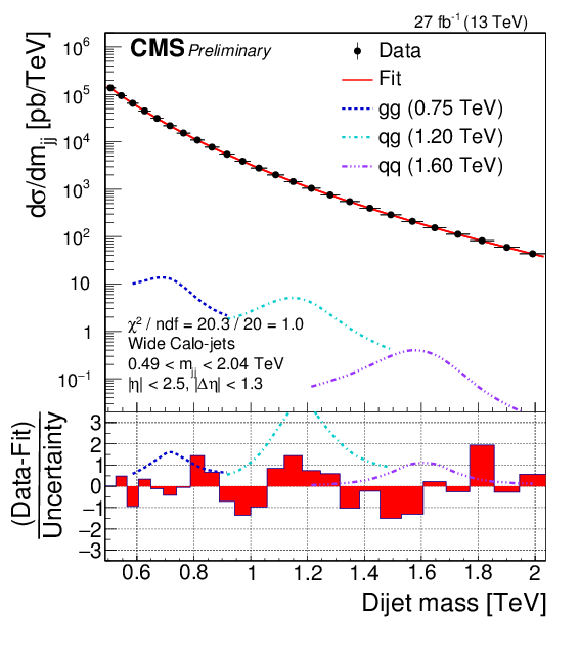
png pdf |
Figure 1-a:
Dijet mass spectra (points) compared to a fitted parameterization of the background (solid curve) for the low-mass search. The lower panel shows the difference between the data and the fitted parametrization, divided by the statistical uncertainty of the data. Examples of predicted signals from narrow gluon-gluon, quark-gluon, and quark-quark resonances are shown with cross sections equal to the observed upper limits at 95% CL. |
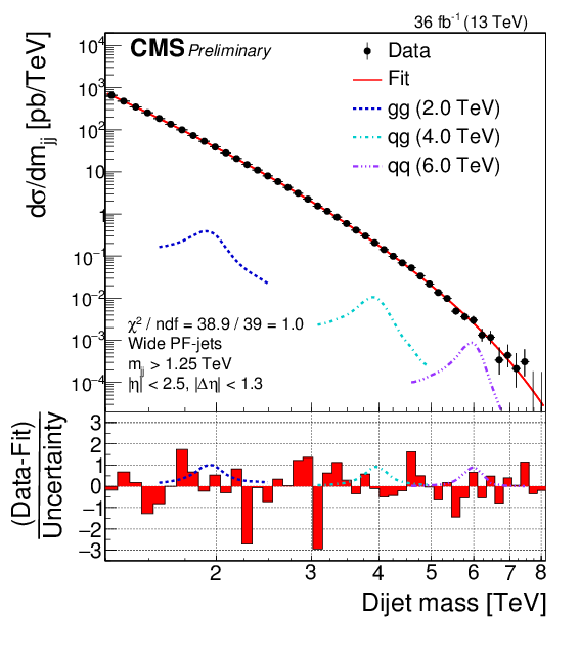
png pdf |
Figure 1-b:
Dijet mass spectra (points) compared to a fitted parameterization of the background (solid curve) for the high-mass search. The lower panel shows the difference between the data and the fitted parametrization, divided by the statistical uncertainty of the data. Examples of predicted signals from narrow gluon-gluon, quark-gluon, and quark-quark resonances are shown with cross sections equal to the observed upper limits at 95% CL. |
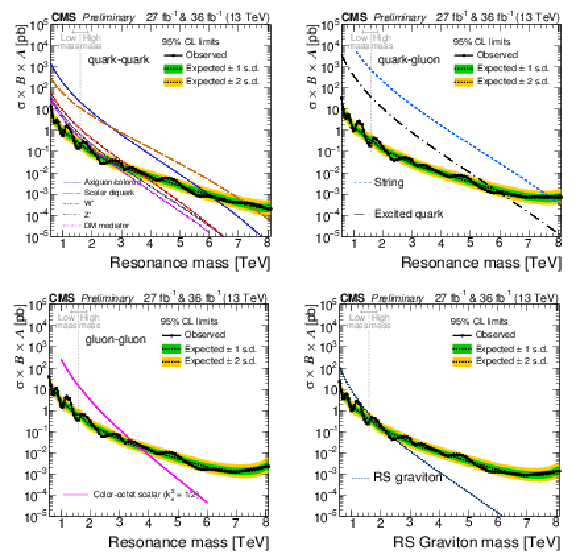
png pdf |
Figure 2:
The observed 95% CL upper limits on the product of the cross section, branching fraction, and acceptance for dijet resonances decaying to quark-quark (top left), quark-gluon (top right), gluon-gluon (bottom left), and for RS gravitons (bottom right). The corresponding expected limits (dashed) and their variations at the 1 and 2 standard deviation levels (shaded bands) are also shown. Limits are compared to predicted cross sections for string resonances [20,21], excited quarks [26,27], axigluons [23], colorons [25], scalar diquarks [22], color-octet scalars [28], new gauge bosons W' and Z' with SM-like couplings [29], dark matter mediators for $m_{\mathrm {DM}}=$ 1 GeV [30,31], and RS gravitons [32]. |
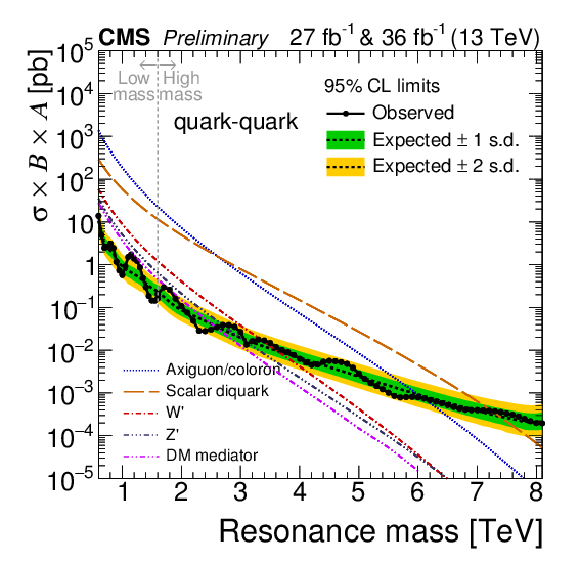
png pdf |
Figure 2-a:
The observed 95% CL upper limits on the product of the cross section, branching fraction, and acceptance for dijet resonances decaying to quark-quark. The corresponding expected limits (dashed) and their variations at the 1 and 2 standard deviation levels (shaded bands) are also shown. Limits are compared to predicted cross sections for axigluons [23], colorons [25], scalar diquarks [22], new gauge bosons W' and Z' with SM-like couplings [29], and dark matter mediators for $m_{\mathrm {DM}}=$ 1 GeV [30,31]. |
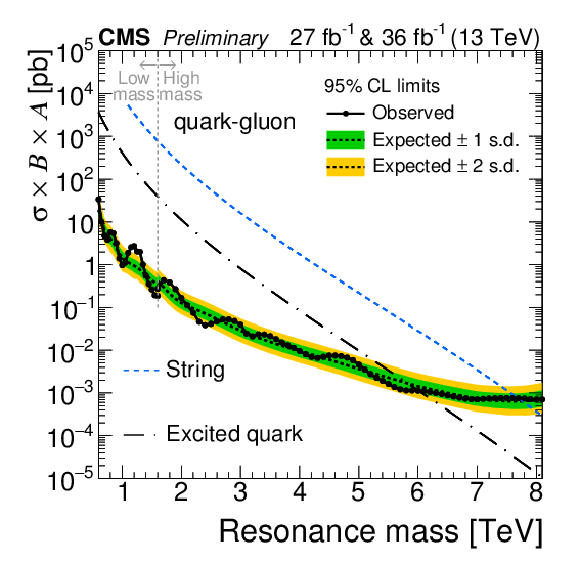
png pdf |
Figure 2-b:
The observed 95% CL upper limits on the product of the cross section, branching fraction, and acceptance for dijet resonances decaying to quark-gluon. The corresponding expected limits (dashed) and their variations at the 1 and 2 standard deviation levels (shaded bands) are also shown. Limits are compared to predicted cross sections for string resonances [20,21] and excited quarks [26,27]. |

png pdf |
Figure 2-c:
The observed 95% CL upper limits on the product of the cross section, branching fraction, and acceptance for dijet resonances decaying to gluon-gluon. The corresponding expected limits (dashed) and their variations at the 1 and 2 standard deviation levels (shaded bands) are also shown. Limits are compared to predicted cross section for color-octet scalars [28]. |
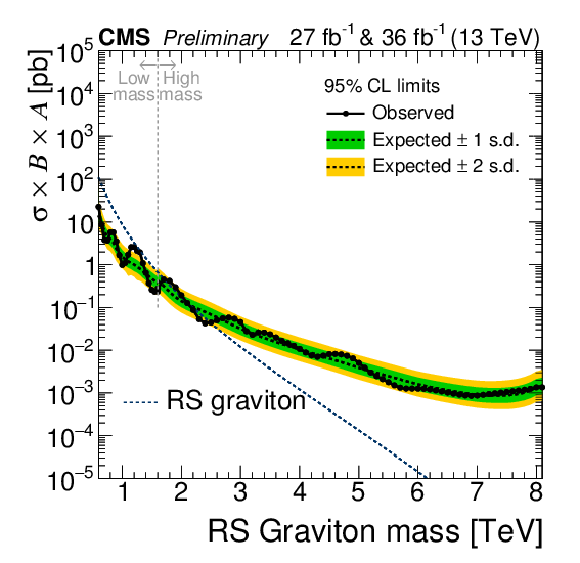
png pdf |
Figure 2-d:
The observed 95% CL upper limits on the product of the cross section, branching fraction, and acceptance for dijet resonances decaying to RS gravitons. The corresponding expected limits (dashed) and their variations at the 1 and 2 standard deviation levels (shaded bands) are also shown. Limits are compared to predicted cross section for RS gravitons [32]. |
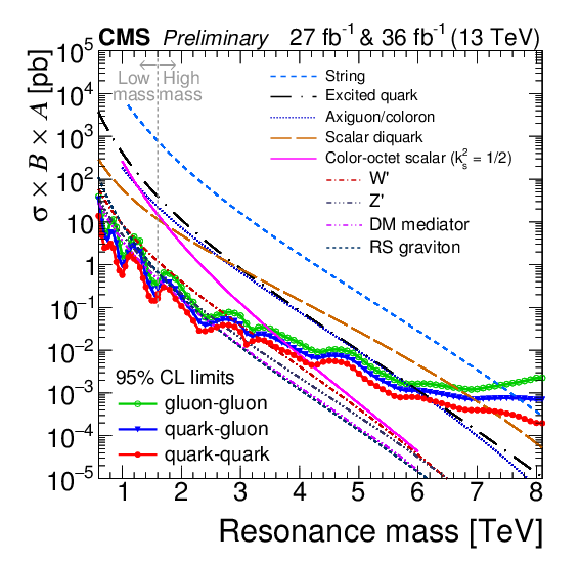
png pdf |
Figure 3:
The observed 95% CL upper limits on the product of the cross section, branching fraction, and acceptance for quark-quark, quark-gluon, and gluon-gluon type dijet resonances. Limits are compared to predicted cross sections for string resonances [20,21], excited quarks [26,27], axigluons [23], colorons [25], scalar diquarks [22], color-octet scalars [28], new gauge bosons W' and Z' with SM-like couplings [29], dark matter mediators for $m_{\mathrm {DM}}=$ 1 GeV [30,31], and RS gravitons [32]. |

png pdf |
Figure 4:
The 95% CL upper limits on the universal quark coupling $ {g_{\mathrm {q}}} ^{\prime }$ as a function of resonance mass for a leptophobic Z' resonance that only couples to quarks. The observed limits (solid), expected limits (dashed) and their variation at the 1 and 2 standard deviation levels (shaded bands) are shown. Dotted horizontal lines show the coupling strength for which the cross section for dijet production in this model is the same as for a DM mediator (see text). |

png pdf |
Figure 5:
The 95% CL observed (solid) and expected (dashed) excluded regions in the plane of dark matter mass vs. mediator mass, for an axial-vector mediator (top) and a vector mediator (bottom), are compared to constraints from the cosmological relic density of DM (light gray) determined from astrophysical measurements [55,56] and MadDM version 2.0.6 [57,58] as described in Ref. [59]. Following the recommendation of the LHC DM working group [30,31], the exclusions are computed for Dirac DM and for a universal quark coupling $ {g_{\mathrm {q}}} = $ 0.25 and for a DM coupling of $ {g_{\text {DM}}} =$ 1.0. It should also be noted that the excluded region strongly depends on the chosen coupling and model scenario. Therefore, the excluded regions and relic density contours shown in this plot are not applicable to other choices of coupling values or models. |
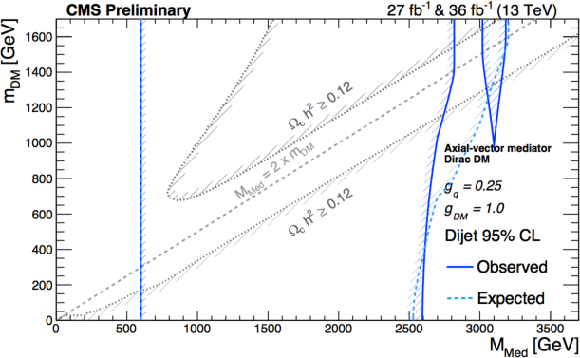
png pdf |
Figure 5-a:
The 95% CL observed (solid) and expected (dashed) excluded regions in the plane of dark matter mass vs. mediator mass, for an axial-vector mediator, are compared to constraints from the cosmological relic density of DM (light gray) determined from astrophysical measurements [55,56] and MadDM version 2.0.6 [57,58] as described in Ref. [59]. Following the recommendation of the LHC DM working group [30,31], the exclusions are computed for Dirac DM and for a universal quark coupling $ {g_{\mathrm {q}}} = $ 0.25 and for a DM coupling of $ {g_{\text {DM}}} =$ 1.0. It should also be noted that the excluded region strongly depends on the chosen coupling and model scenario. Therefore, the excluded regions and relic density contours shown in this plot are not applicable to other choices of coupling values or models. |

png pdf |
Figure 5-b:
The 95% CL observed (solid) and expected (dashed) excluded regions in the plane of dark matter mass vs. mediator mass, for a vector mediator, are compared to constraints from the cosmological relic density of DM (light gray) determined from astrophysical measurements [55,56] and MadDM version 2.0.6 [57,58] as described in Ref. [59]. Following the recommendation of the LHC DM working group [30,31], the exclusions are computed for Dirac DM and for a universal quark coupling $ {g_{\mathrm {q}}} = $ 0.25 and for a DM coupling of $ {g_{\text {DM}}} =$ 1.0. It should also be noted that the excluded region strongly depends on the chosen coupling and model scenario. Therefore, the excluded regions and relic density contours shown in this plot are not applicable to other choices of coupling values or models. |
| Tables | |
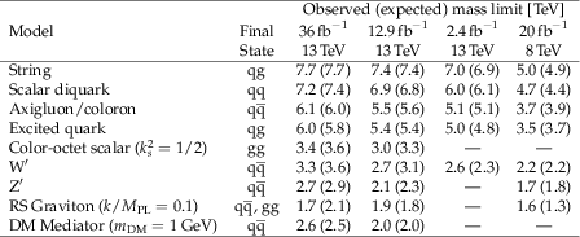
png pdf |
Table 1:
Observed and expected mass limits at 95% CL from this analysis with 36fb$^{-1}$ at $\sqrt {s}=13$ TeV compared to previously published limits on narrow resonances from CMS with 12.9fb$^{-1}$ and 2.4fb$^{-1}$ at $\sqrt {s}=$ 13 TeV [6,3] and with 20fb$^{-1}$ at $\sqrt {s}=$ 8 TeV [8]. The listed models are excluded between 0.6 TeV and the indicated mass limit by this analysis. In addition to the observed mass limits listed below, this analysis also excludes the RS Graviton model within the mass interval between 2.1 and 2.5 TeV and the Z' model within roughly a 50 GeV window around 3.1 TeV. |
| Summary |
| Two searches for narrow resonances decaying into a pair of jets have been performed using proton-proton collisions at $\sqrt{s}= $ 13 TeV corresponding to an integrated luminosity of up to 36 fb$^{-1}$: a low-mass search based on calorimeter jets, reconstructed by the high level trigger and recorded in compact form (data scouting), and a high-mass search based on particle-flow jets. The dijet mass spectra are observed to be smoothly falling distributions. In the analyzed data samples, there is no evidence for resonant particle production. Generic upper limits are presented on the product of the cross section, the branching fraction, and the acceptance for narrow quark-quark, quark-gluon, and gluon-gluon resonances that are applicable to any model of narrow dijet resonance production. String resonances with masses below 7.7 TeV are excluded at 95% confidence level, as are scalar diquarks below 7.2 TeV, axigluons and colorons below 6.1 TeV, excited quarks below 6.0 TeV, color-octet scalars below 3.4 TeV, W' bosons below 3.3 TeV, Z' bosons with SM-like couplings below 2.7 TeV, and Randall-Sundrum gravitons below 1.7 TeV and between 2.1 and 2.5 TeV, and dark matter mediators below 2.6 TeV. The limits on both vector and axial-vector mediators, in a simplified model of interactions between quarks and dark matter, are also presented as functions of dark matter mass and are compared to the exclusions of dark matter in direct detection experiments. This extends previously reported limits in the dijet channel. |
| Additional Figures | |
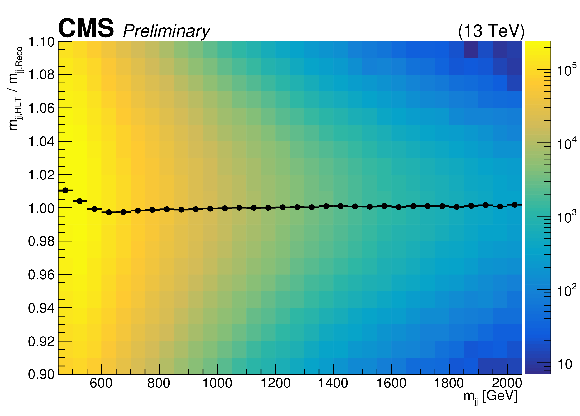
png pdf |
Additional Figure 1:
The ratio of the dijet invariant mass built from Calo-jets recorded at HLT divided by that for PF-jets from offline reconstruction, shown as a function of randomly chosen Calo-jet or PF-jet dijet mass to reduce resolution biases. The average value of the ratio is shown by the black points. The colored scale on the z-axis gives the number of events in this monitoring sample, which is a subset of the full dataset for which the information from both types of jets is available. |
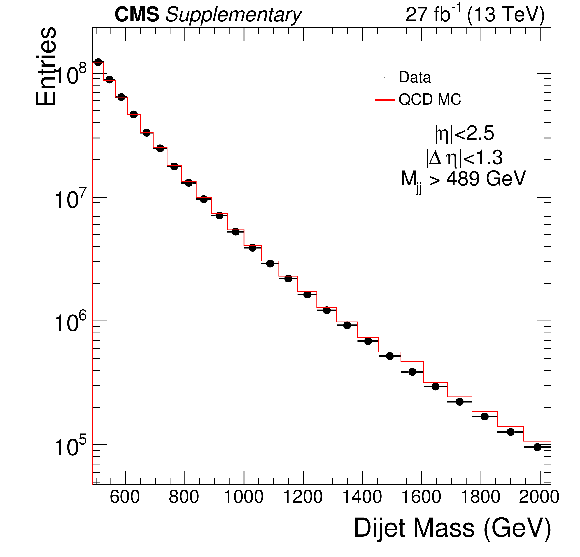
png pdf |
Additional Figure 2:
The dijet mass of the two wide jets after all selection criteria are applied, for data from the low-mass search (points) and PYTHIA-8 MC with detector simulation (histogram) normalized to the data. |

png pdf |
Additional Figure 3:
The azimuthal angular separation between the two wide-jets after all selection criteria are applied, for data from the low-mass search (points) and PYTHIA-8 MC with detector simulation (histogram) normalized to the data. |
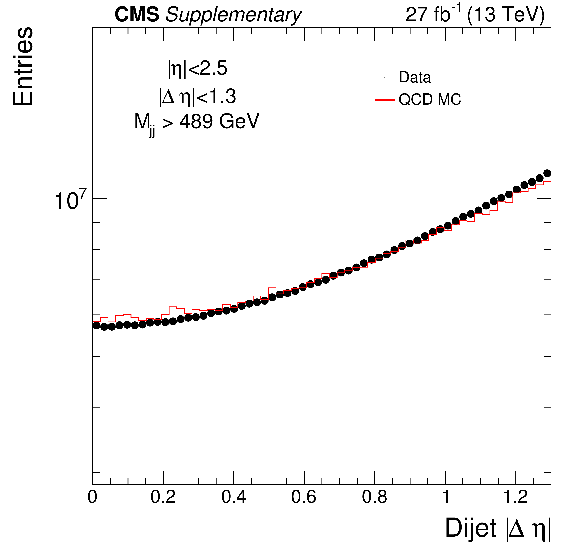
png pdf |
Additional Figure 4:
The absolute difference in pseudorapidity between the two wide-jets after all selection criteria are applied, for data from the low-mass search (points) and PYTHIA-8 MC with detector simulation (histogram) normalized to the data. |
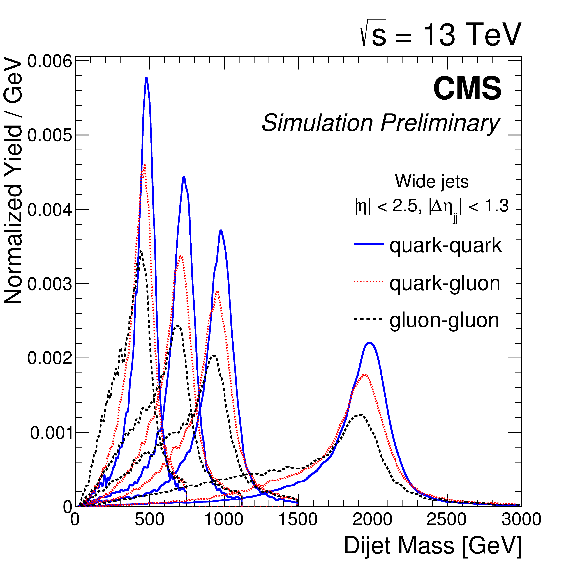
png pdf |
Additional Figure 5:
Signal shapes for the low mass search. The reconstructed resonance mass spectrum predicted by the PYTHIA-8 MC event generator including simulation of the CMS detector. Resonances from quark-quark processes modeled by $\mathrm{ q } \mathrm{ \bar{q} } \to \mathrm{G}\to \mathrm{ q } \mathrm{ \bar{q} } $ (blue), quark-gluon processes modeled by $\mathrm{ q } \mathrm{g} \to \mathrm{q}^{*} \to \mathrm{ q } \mathrm{g} $ (red), and gluon-gluon processes modeled by $\mathrm{g} \mathrm{g} \to \mathrm{G}\to \mathrm{g} \mathrm{g} $ (black), where $\mathrm{G}$ is an RS graviton and $\mathrm{q}^{*}$ is an excited quark. Resonances generated with a mass of 0.5, 0.75, 1.0 and 2.0 TeV are shown for wide jets from calo-jet reconstruction. |
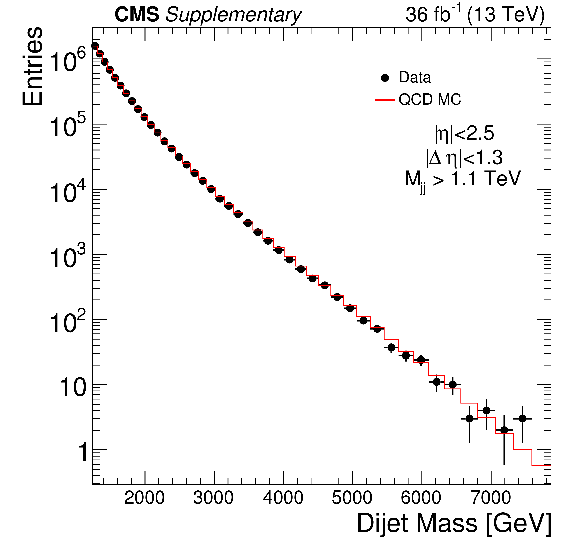
png pdf |
Additional Figure 6:
The dijet mass of the two wide jets after all selection criteria are applied, for data from the high-mass search (points) and PYTHIA-8 MC with detector simulation (histogram) normalized to the data. |

png pdf |
Additional Figure 7:
The azimuthal angular separation between the two wide-jets after all selection criteria are applied, for data from the high-mass search (points) and PYTHIA-8 MC with detector simulation (histogram) normalized to the data. |
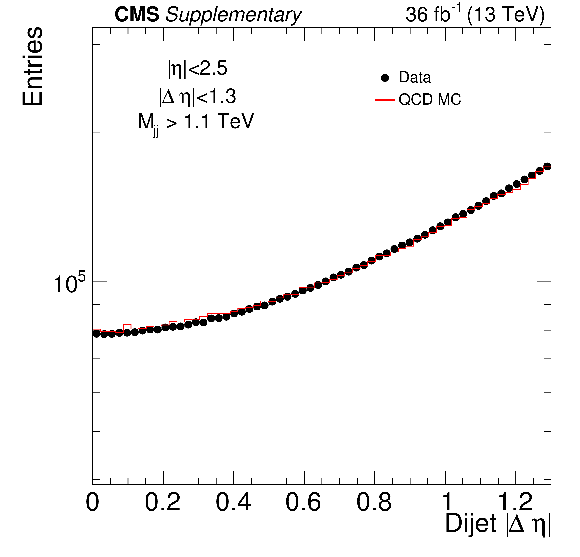
png pdf |
Additional Figure 8:
The absolute difference in pseudorapidity between the two wide-jets after all selection criteria are applied, for data from the high-mass search (points) and PYTHIA-8 MC with detector simulation (histogram) normalized to the data. |

png pdf |
Additional Figure 9:
Signal shapes for the high mass search. The reconstructed resonance mass spectrum predicted by the PYTHIA-8 MC event generator including simulation of the CMS detector. Resonances from quark-quark processes modeled by $\mathrm{ q } \mathrm{ \bar{q} } \to \mathrm{G}\to \mathrm{ q } \mathrm{ \bar{q} } $ (blue), quark-gluon processes modeled by $\mathrm{ q } \mathrm{g} \to \mathrm{q}^{*} \to \mathrm{ q } \mathrm{g} $ (red), and gluon-gluon processes modeled by $\mathrm{g} \mathrm{g} \to \mathrm{G}\to \mathrm{g} \mathrm{g} $ (black), where $\mathrm{G}$ is an RS graviton and $\mathrm{q}^{*}$ is an excited quark. Resonances generated with a mass of 2, 4, 6 and 8 TeV are shown for wide jets from PF-jet reconstruction. |
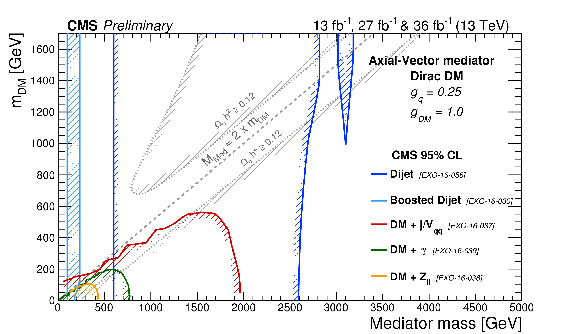
png pdf |
Additional Figure 10:
The 95% CL observed excluded regions for an axial-vector mediator in the plane of dark matter mass vs. mediator mass for this analysis using 27 fb$^{-1}$ and 36 fb$^{-1}$ in the dijet channel (dark blue) in comparison with the results using 2.7 fb$^{-1}$ from boosted dijets (light blue) and the results using 13 fb$^{-1}$ from MET + X searches in the mono-jet channel (red), mono-photon channel (green) and mono-Z channel (yellow), are compared to constraints from the cosmological relic density of DM (light gray). The exclusions are computed for Dirac DM and for a universal quark coupling $g_{\mathrm {q}}= $ 0.25 and for a DM coupling of $g_{\text {DM}}=$ 1.0. It should also be noted that the excluded region strongly depends on the chosen coupling and model scenario. Therefore, the excluded regions and relic density contours shown in this plot are not applicable to other choices of coupling values or models. |

png pdf |
Additional Figure 11:
The 95% CL observed excluded regions for a vector mediator in the plane of dark matter mass vs. mediator mass for this analysis using 27 fb$^{-1}$ and 36 fb$^{-1}$ in the dijet channel (dark blue) in comparison with the results using 2.7 fb$^{-1}$ from boosted dijets (light blue) and using 13 fb$^{-1}$ from MET + X searches in the mono-jet channel (red), mono-photon channel (green) and mono-Z channel (yellow), are compared to constraints from the cosmological relic density of DM (light gray). The exclusions are computed for Dirac DM and for a universal quark coupling $g_{\mathrm {q}}= $ 0.25 and for a DM coupling of $g_{\text {DM}}=$ 1.0. It should also be noted that the excluded region strongly depends on the chosen coupling and model scenario. Therefore, the excluded regions and relic density contours shown in this plot are not applicable to other choices of coupling values or models. |

png pdf |
Additional Figure 12:
Excluded regions at 90% CL in the plane of spin-dependent dark matter nucleon interaction cross section vs. dark matter mass. The CMS exclusion from the dijet channel (shaded) is compared with limits from PICASSO, Super-Kamiokande, IceCube, and PICO-60. The CMS exclusions are for Dirac DM and couplings $g_{\mathrm {q}}= $ 0.25 and $g_{\text {DM}}=$ 1.0, for leptophobic axial-vector mediators, and they strongly depend on these choices and are not applicable to other choices of coupling values or models. |
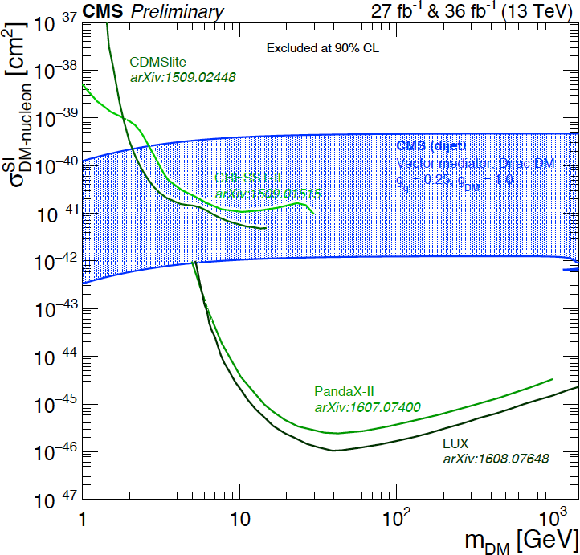
png pdf |
Additional Figure 13:
Excluded regions at 90% CL in the plane of spin-independent dark matter nucleon interaction cross section vs. dark matter mass. The CMS exclusion from the dijet channel (shaded) is compared with limits from LUX, PandaX-II, CDMSLite, and CRESST-II. The CMS exclusions are for Dirac DM and couplings $g_{\mathrm {q}}= $ 0.25 and $g_{\text {DM}}=$ 1.0, for leptophobic vector mediators, and they strongly depend on these choices and are not applicable to other choices of coupling values or models. |
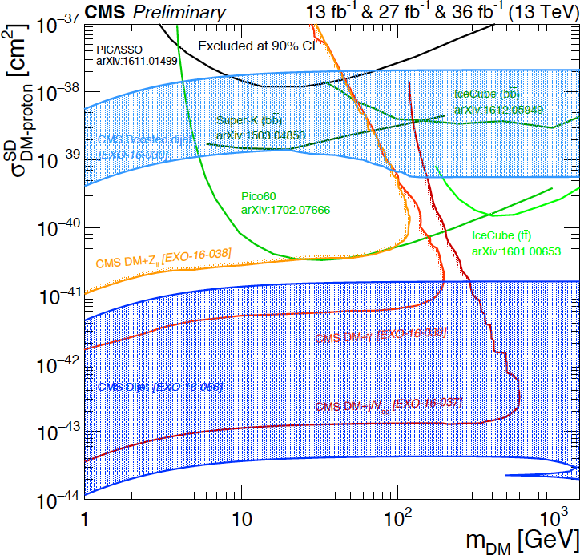
png pdf |
Additional Figure 14:
Excluded regions at 90% CL in the plane of spin-dependent dark matter nucleon interaction cross section vs. dark matter mass. The CMS exclusion from this analysis using 27 fb$^{-1}$ and 36 fb$^{-1}$ in the dijet channel (dark blue shaded) in comparison with the results using 2.7 fb$^{-1}$ from boosted dijets (light blue shaded) and the results using 13 fb$^{-1}$ from MET + X searches in the mono-jet channel (dark red), mono-photon channel (light red) and mono-Z channel (orange), are compared with limits from PICASSO, Super-Kamiokande, IceCube, and PICO-60. The CMS exclusions are for Dirac DM and couplings $g_{\mathrm {q}}= $ 0.25 and $g_{\text {DM}}=$ 1.0, for leptophobic axial-vector mediators, and they strongly depend on these choices and are not applicable to other choices of coupling values or models. |
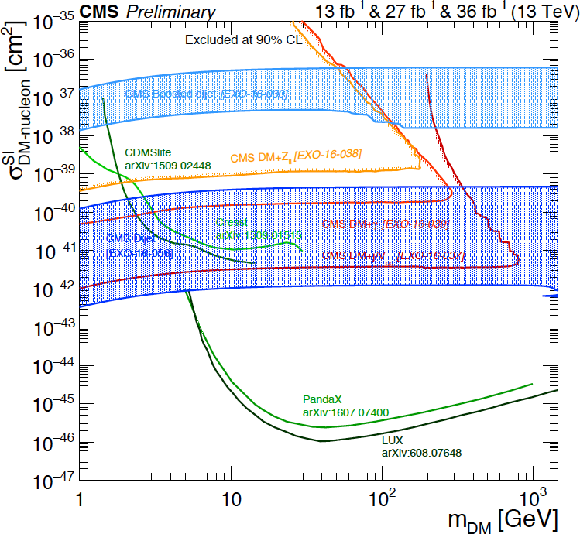
png pdf |
Additional Figure 15:
Excluded regions at 90% CL in the plane of spin-independent dark matter nucleon interaction cross section vs. dark matter mass. The CMS exclusion from this analysis using 27 fb$^{-1}$ and 36 fb$^{-1}$ in the dijet channel (dark blue shaded) in comparison with the results using 2.7 fb$^{-1}$ from boosted dijets (light blue shaded) and the results using 13 fb$^{-1}$ from MET + X searches in the mono-jet channel (dark red), mono-photon channel (light red) and mono-Z channel (orange), are compared with limits from LUX, PandaX-II, CDMSLite, and CRESST-II. The CMS exclusions are for Dirac DM and couplings $g_{\mathrm {q}}= $ 0.25 and $g_{\text {DM}}=$ 1.0, for leptophobic vector mediators, and they strongly depend on these choices and are not applicable to other choices of coupling values or models. |
| Additional Tables | |

png pdf |
Additional Table 1:
Limits from the low-mass search. CMS preliminary observed and expected upper limits at 95% CL on $\sigma \times B \times A$ for a $\mathrm{g} \mathrm{g} $ resonance, a $\mathrm{ q } \mathrm{g} $ resonance, a $\mathrm{ q } \mathrm{ q } $ resonance, and an RS Graviton as a function of the resonance mass. |

png pdf |
Additional Table 2:
Limits from the high-mass search. CMS preliminary observed and expected upper limits at 95% CL on $\sigma \times B \times A$ for a $\mathrm{g} \mathrm{g} $ resonance, a $\mathrm{ q } \mathrm{g} $ resonance, a $\mathrm{ q } \mathrm{ q } $ resonance, and an RS Graviton as a function of the resonance mass. |
| References | ||||
| 1 | M. Chala et al. | Constraining dark sectors with monojets and dijets | JHEP 07 (2015) 089 | 1503.05916 |
| 2 | CMS Collaboration | Data Parking and Data Scouting at the CMS Experiment | CDS | |
| 3 | CMS Collaboration | Search for dijet resonances in proton-proton collisions at $ \sqrt{s}= $ 13 TeV and constraints on dark matter and other models | Submitted to PLB | CMS-EXO-16-032 1611.03568 |
| 4 | CMS Collaboration | Search for Narrow Resonances in Dijet Final States at $ \sqrt{s}= $ 8 TeV with the Novel CMS Technique of Data Scouting | PRL 117 (2016) 031802 | CMS-EXO-14-005 1604.08907 |
| 5 | ATLAS Collaboration | Search for light dijet resonances with the ATLAS detector using a Trigger-object Level Analysis in LHC pp collisions at $ \sqrt{s}= $ 13 TeV | ATLAS Conference Report ATLAS-CONF-2016-030, Jun | |
| 6 | CMS Collaboration | Search for Narrow Resonances Decaying to Dijets in Proton-Proton Collisions at $ \sqrt{s} = $ 13 TeV | PRL 116 (2016) 071801 | CMS-EXO-15-001 1512.01224 |
| 7 | ATLAS Collaboration | Search for new phenomena in dijet mass and angular distributions from pp collisions at $ \sqrt{s}= $ 13 TeV with the ATLAS detector | PLB 754 (2016) 302 | 1512.01530 |
| 8 | CMS Collaboration | Search for resonances and quantum black holes using dijet mass spectra in proton-proton collisions at $ \sqrt{s}= $ 8 TeV | PRD 91 (2015) 052009 | CMS-EXO-12-059 1501.04198 |
| 9 | ATLAS Collaboration | Search for new phenomena in the dijet mass distribution using pp collision data at $ \sqrt{s}= $ 8 TeV with the ATLAS detector | PRD 91 (2015) 052007 | 1407.1376 |
| 10 | CMS Collaboration | Search for narrow resonances using the dijet mass spectrum in pp collisions at $ \sqrt{s}= $ 8 TeV | PRD 87 (2013) 114015 | CMS-EXO-12-016 1302.4794 |
| 11 | CMS Collaboration | Search for narrow resonances and quantum black holes in inclusive and b-tagged dijet mass spectra from pp collisions at $ \sqrt{s}= $ 7 TeV | JHEP 01 (2013) 013 | CMS-EXO-11-094 1210.2387 |
| 12 | ATLAS Collaboration | Search for new physics in the dijet mass distribution using 1 fb$ ^{-1} $ of $ pp $ collision data at $ \sqrt{s}= $ 7 TeV collected by the ATLAS detector | PLB 708 (2012) 37 | 1108.6311 |
| 13 | ATLAS Collaboration | ATLAS search for new phenomena in dijet mass and angular distributions using pp collisions at $ \sqrt{s}= $ 7 TeV | JHEP 01 (2013) 029 | 1210.1718 |
| 14 | CMS Collaboration | Search for resonances in the dijet mass spectrum from 7 TeV pp collisions at CMS | PLB 704 (2011) 123 | CMS-EXO-11-015 1107.4771 |
| 15 | ATLAS Collaboration | Search for new physics in dijet mass and angular distributions in $ pp $ collisions at $ \sqrt{s}= $ 7 TeV measured with the ATLAS detector | New J. Phys. 13 (2011) 053044 | 1103.3864 |
| 16 | CMS Collaboration | Search for Dijet Resonances in 7 TeV pp Collisions at CMS | PRL 105 (2010) 211801, , [Erratum \DOI10.1103/PhysRevLett.106.029902] | CMS-EXO-10-010 1010.0203 |
| 17 | ATLAS Collaboration | Search for New Particles in Two-Jet Final States in 7 TeV Proton-Proton Collisions with the ATLAS Detector at the LHC | PRL 105 (2010) 161801 | 1008.2461 |
| 18 | R. M. Harris and K. Kousouris | Searches for dijet resonances at hadron colliders | Int. J. Mod. Phys. A 26 (2011) 5005 | 1110.5302 |
| 19 | ATLAS Collaboration | Search for New Phenomena in Dijet Events with the ATLAS Detector at $ \sqrt{s}= $ 13 TeV with 2015 and 2016 data | ATLAS Conference Report ATLAS-CONF-2016-069, Aug | |
| 20 | L. A. Anchordoqui et al. | Dijet Signals for Low Mass Strings at the LHC | PRL 101 (2008) 241803 | 0808.0497 |
| 21 | S. Cullen, M. Perelstein, and M. E. Peskin | TeV strings and collider probes of large extra dimensions | PRD 62 (2000) 055012 | hep-ph/0001166 |
| 22 | J. L. Hewett and T. G. Rizzo | Low-energy phenomenology of superstring-inspired E(6) models | PR 183 (1989) 193 | |
| 23 | P. H. Frampton and S. L. Glashow | Chiral Color: An Alternative to the Standard Model | PLB 190 (1987) 157 | |
| 24 | R. S. Chivukula, E. H. Simmons, A. Farzinnia, and J. Ren | Hadron collider production of massive color-octet vector bosons at next-to-leading order | PRD 87 (2013) 094011 | 1303.1120 |
| 25 | E. H. Simmons | Coloron phenomenology | PRD 55 (1997) 1678 | hep-ph/9608269 |
| 26 | U. Baur, I. Hinchliffe, and D. Zeppenfeld | Excited Quark Production at Hadron Colliders | Int. J. Mod. Phys. A 02 (1987) 1285 | |
| 27 | U. Baur, M. Spira, and P. M. Zerwas | Excited quark and lepton production at hadron colliders | PRD 42 (1990) 815 | |
| 28 | T. Han, I. Lewis, and Z. Liu | Colored resonant signals at the LHC: largest rate and simplest topology | JHEP 12 (2010) 085 | 1010.4309 |
| 29 | E. Eichten, I. Hinchliffe, K. D. Lane, and C. Quigg | Supercollider physics | Rev. Mod. Phys. 56 (1984) 579 | |
| 30 | A. Boveia et al. | Recommendations on presenting LHC searches for missing transverse energy signals using simplified $ s $-channel models of dark matter | 1603.04156 | |
| 31 | J. Abdallah et al. | Simplified models for dark matter searches at the LHC | Phys. Dark Univ. 9-10 (2015) 8 | 1506.03116 |
| 32 | L. Randall and R. Sundrum | An alternative to compactification | PRL 83 (1999) 4690 | hep-th/9906064 |
| 33 | R. S. Chivukula, E. H. Simmons, and N. Vignaroli | Distinguishing dijet resonances at the LHC | PRD 91 (2015) 055019 | 1412.3094 |
| 34 | CMS Collaboration | The CMS experiment at the CERN LHC | JINST 3 (2008) S08004 | CMS-00-001 |
| 35 | CMS Collaboration | Particle--Flow Event Reconstruction in CMS and Performance for Jets, Taus, and $ E_{\mathrm{T}}^{\text{miss}} $ | CDS | |
| 36 | CMS Collaboration | Commissioning of the Particle-flow Event Reconstruction with the first LHC collisions recorded in the CMS detector | CDS | |
| 37 | M. Cacciari, G. P. Salam, and G. Soyez | The Anti-$ k_\mathrm{t} $ jet clustering algorithm | JHEP 04 (2008) 063 | 0802.1189 |
| 38 | M. Cacciari and G. P. Salam | Dispelling the $ N^{3} $ myth for the $ k_\mathrm{t} $ jet-finder | PLB 641 (2006) 57 | hep-ph/0512210 |
| 39 | M. Cacciari, G. P. Salam, and G. Soyez | FastJet user manual | EPJC 72 (2012) 1896 | 1111.6097 |
| 40 | M. Cacciari and G. P. Salam | Pileup subtraction using jet areas | PLB 659 (2008) 119 | 0707.1378 |
| 41 | CMS Collaboration | Jet energy scale and resolution in the CMS experiment in pp collisions at 8 TeV | Submitted to JINST | CMS-JME-13-004 1607.03663 |
| 42 | CMS Collaboration | Jet Performance in pp Collisions at $ \sqrt{s}= $ 7 TeV | CDS | |
| 43 | CDF Collaboration | Search for new particles decaying into dijets in proton-antiproton collisions at $ \sqrt{s}= $ 1.96 TeV | PRD 79 (2009) 112002 | 0812.4036 |
| 44 | R. G. Lomax and D. L. Hahs-Vaughn | Fisher Test | Routledge Academic, London | |
| 45 | T. Sjostrand, S. Mrenna, and P. Skands | A brief introduction to PYTHIA 8.1 | Comp. Phys. Comm. 178 (2008) 852 | 0710.3820 |
| 46 | CMS Collaboration | Event generator tunes obtained from underlying event and multiparton scattering measurements | EPJC 76 (2016) 155 | CMS-GEN-14-001 1512.00815 |
| 47 | P. Skands, S. Carrazza, and J. Rojo | Tuning PYTHIA 8.1: the Monash 2013 tune | EPJC 74 (2014) 3024 | 1404.5630 |
| 48 | GEANT4 Collaboration | GEANT4 --- a simulation toolkit | NIMA 506 (2003) 250 | |
| 49 | T. Junk | Confidence level computation for combining searches with small statistics | Nucl. Instr. Meth. A 434 (1999) 435 | hep-ex/9902006 |
| 50 | A. L. Read | Presentation of search results: the $ CL_s $ technique | JPG 28 (2002) 2693 | |
| 51 | LHC Higgs Combination Group | Procedure for the LHC Higgs boson search combination in Summer 2011 | CMS-NOTE-2011-005 | |
| 52 | G. Cowan, K. Cranmer, E. Gross, and O. Vitells | Asymptotic formulae for likelihood-based tests of new physics | EPJC 71 (2011) 1554 | 1007.1727 |
| 53 | J. Pumplin et al. | New generation of parton distributions with uncertainties from global QCD analysis | JHEP 07 (2002) 012 | hep-ph/0201195 |
| 54 | B. A. Dobrescu and F. Yu | Coupling-mass mapping of dijet peak searches | PRD 88 (2013) 035021 | 1306.2629 |
| 55 | WMAP Collaboration | Wilkinson Microwave Anisotropy Probe (WMAP) three year results: implications for cosmology | Astrophys. J. Suppl. 170 (2007) 377 | astro-ph/0603449 |
| 56 | Planck Collaboration | Planck 2013 results. XVI. Cosmological parameters | Astron. Astrophys. 571 (2014) A16 | 1303.5076 |
| 57 | M. Backovic, K. Kong, and M. McCaskey | MadDM v.1.0: Computation of Dark Matter Relic Abundance Using MadGraph5 | Phys. Dark Univ. 5 (2014) 18 | 1308.4955 |
| 58 | M. Backovic et al. | Direct detection of dark matter with MadDM v.2.0 | Phys. Dark Univ. 9 (2015) 37 | 1505.04190 |
| 59 | T. du Pree, K. Hahn, P. Harris, and C. Roskas | Cosmological constraints on Dark Matter models for collider searches | 1603.08525 | |
| 60 | E. Behnke et al. | Final Results of the PICASSO Dark Matter Search Experiment | Astropart. Phys. 90 (2017) 85--92 | 1611.01499 |
| 61 | PICO Collaboration | Dark Matter Search Results from the PICO-60 C$ _3 $F$ _8 $ Bubble Chamber | 1702.07666 | |
| 62 | IceCube Collaboration | Search for annihilating dark matter in the Sun with 3 years of IceCube data | EPJC77 (2017), no. 3, 146 | 1612.05949 |
| 63 | IceCube Collaboration | Improved limits on dark matter annihilation in the Sun with the 79-string IceCube detector and implications for supersymmetry | JCAP 04 (2016) 022 | 1601.00653 |
| 64 | Super-Kamiokande Collaboration | Search for Neutrinos from Annihilation of Captured Low-Mass Dark Matter Particles in the Sun by Super-Kamiokande | PRL 114 (2015) 141301 | 1503.04858 |
| 65 | LUX Collaboration | Results from a search for dark matter in LUX with 332 live days of exposure | 1608.07648 | |
| 66 | PandaX-II Collaboration | Dark Matter Results from First 98.7 Days of Data from the PandaX-II Experiment | PRL 117 (2016) 121303 | 1607.07400 |
| 67 | SuperCDMS Collaboration | New Results from the Search for Low-Mass Weakly Interacting Massive Particles with the CDMS Low Ionization Threshold Experiment | PRL 106 (2016) 071301 | 1509.02448 |
| 68 | CRESST Collaboration | Results on light dark matter particles with a low-threshold CRESST-II detector | EPJC 76 (2016) 25 | 1509.01515 |

|
Compact Muon Solenoid LHC, CERN |

|

|

|

|

|

|